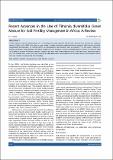| dc.contributor.author | PA Opala | |
| dc.date.accessioned | 2022-01-21T13:27:07Z | |
| dc.date.available | 2022-01-21T13:27:07Z | |
| dc.date.issued | 2020 | |
| dc.identifier.uri | https://repository.maseno.ac.ke/handle/123456789/4475 | |
| dc.description | URL:https://scholar.google.com/citations | en_US |
| dc.description.abstract | Tithonia biomass transfer was presented as a technology that would replenish infertile soils, enhance food security and eradicate
poverty in Africa in the 1990s. Since then, a huge volume of research has been conducted and the agronomic effectiveness of tithonia
unequivocally demonstrated. Its reported effects on soil properties have however been inconsistent. This has made it difficult to
develop a predictive understanding of the effects of tithonia on soil properties. Socio-economically, tithonia failed to live up to the hype
on its ability to increase the farmers’ incomes. Adoption rates have been dismal mainly because of high labor costs associated with its
use. Two decades later, poverty and food insecurity are still widespread in Africa despite the enormous research and extension efforts
that were devoted to popularizing the technology. | en_US |
| dc.publisher | Agricultural Research Communication Centre | en_US |
| dc.subject | Adoption, Socioeconomics, Soil, Tithonia research. | en_US |
| dc.title | Recent advances in the use of Tithonia diversifolia green manure for soil fertility management in Africa: A review | en_US |
| dc.type | Article | en_US |

